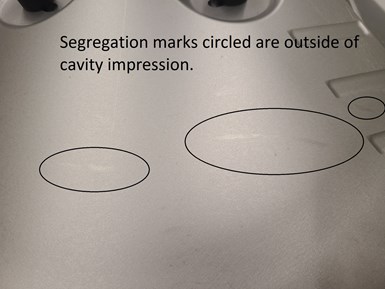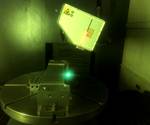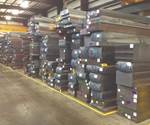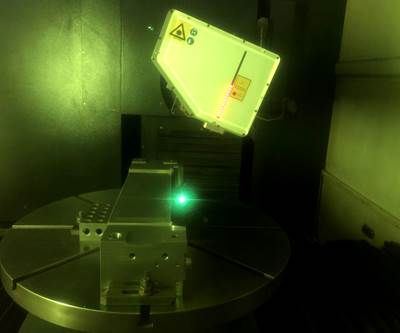
A mold cavity, ready for laser texture application. Photo Credit, all images: Custom Etch Inc.
The increased use of plastic parts has increased the application of textured surfaces to their finish. Textures can be applied for aesthetic and functional purposes.
Pattern designs have progressed from simple, leather-like or random deep surfaces to very shallow stipple or geometric shapes that display intricate, delicate appearances.
Traditionally, shops use acid etching to apply mold textures into steel surfaces, which requires a lot of upfront preparation — disassembling the mold, cleaning the surface and manually protecting areas not to be textured.
First, texture areas are blasted for pattern adhesion, and then a transfer film is manually placed and carefully mated to assure the texture does not show any mismatches. Acid is then applied to chemically etch away the metal and create the desired surface pattern. After exposure, the mold is blasted again to remove any residues and for gloss adjustment. This process can take days for simple patterns or several weeks for more complex and custom patterns. Laser texturing, however, is an alternative option that applies the controlled use of digital lasers to ablate or remove the metal in a designated pattern.
Digital laser technology does not require any preparation. It also offers freedom of design, safety, higher quality, unlimited design options, blended patterns with seamless transitions and features not possible with acid etching. In addition, five-axis CNC lasers apply patterns directly to the surface with no environmental issues for chemical disposal.
Laser texturing, however, is an alternative option that applies the controlled use of digital lasers to ablate or remove the metal in a designated pattern.
Eliminate Streaks
The occasional appearance of streaks in the textured steel surface can arise from acid etching. These single or multiple areas appear as lighter or darker lines in the desired pattern and transfer to the surface of the molded plastic parts.

The segregation marks circled are outside of the cavity impression.
Steel suppliers have traced texture streaks to elemental segregation within the steel blocks used for molds. Segregation occurs when certain steel elements separate during initial metal solidification and form areas that react differently when applying a texture with acid etching. Segregation is present to some degree in all steels and is a natural phenomenon that is difficult to measure or predict inside a raw mold block.
Tackle Weld Repair
A textured mold can sometimes require welding for repair or design revisions. The weld deposit is likely slightly different in chemistry or hardness from the original base metal. Using acid to retexture the weld area may not match the original texture. Lasers are unaffected by weld or hardness issues and will produce a result as good as the original.

Laser texture shows no segregation.
High-volume textured molds will show wear that requires a reapplication of the surface pattern. Lasers can fully replicate the pattern,whereas a second acid-etched texture may vary slightly.
This is critical when multiple new molds are required to display identically matched textures, such as family molds for interior automotive parts. Automotive OEMs demand perfect texture matches despite possible differences in the mold materials used.
Related Content
Precision Welding Services Offer Rapid Turnaround Mold Repair and Reduced Molder Downtime
X-Cell Tool & Mold relies on outsourced, high-quality welding repairs from Lewis-Bawol Welding to ensure its customers' molds are back in production quickly and affordably.
Read MoreWhat You Need to Know About Hot Runner Systems and How to Optimize Their Performance
How to make the most out of the hot runner design, function and performance.
Read MoreWhat is Scientific Maintenance? Part 2
Part two of this three-part series explains specific data that toolrooms must collect, analyze and use to truly advance to a scientific maintenance culture where you can measure real data and drive decisions.
Read MoreVIDEO: Hot Runner Maintenance Tips
Scott Clark, Hot Runner Business Manager for Husky Technologies, breaks down maintenance practices for hot runner systems.
Read MoreRead Next
The Advantages of Digital Laser Technology for Mold Texturing
Understanding the nuances and benefits of laser ablation and when to use it.
Read MorePerformance and Price Drive Developments in Mold Materials
Mold material suppliers are working to develop new, improved mold-material grades that will deliver on customers’ need for machinability, toughness, thermal conductivity and price.
Read MoreHigher-Level Laser Mold Texturing
Eroded, sandblasted and chemically-etched mold textures are now 100-percent lasered at this Germany-based service provider.
Read More



.jpg;maxWidth=150;quality=70)




.png;maxWidth=300;quality=90)


_300x250 4.png;maxWidth=300;quality=90)













.jpg;maxWidth=400;quality=70)
